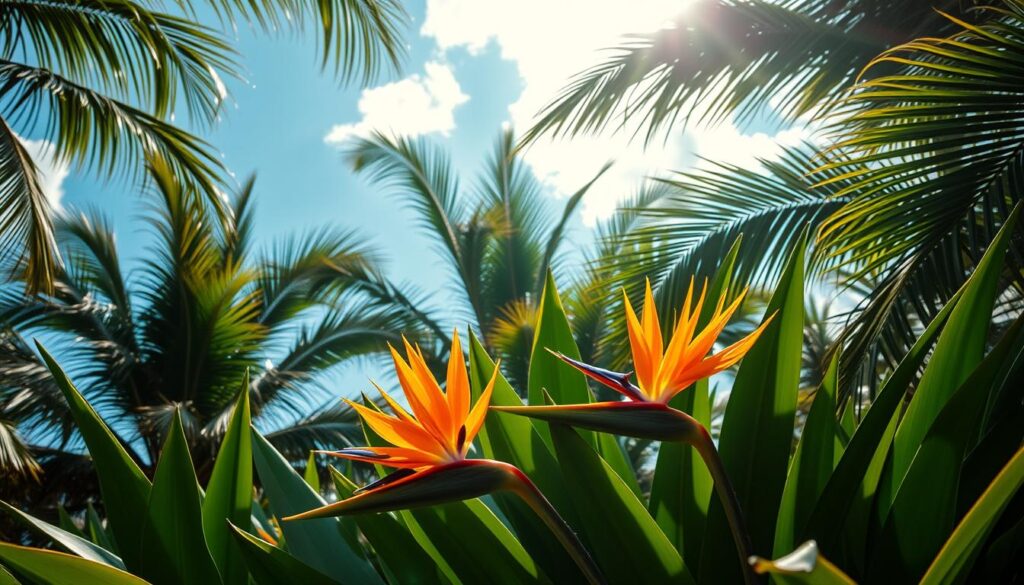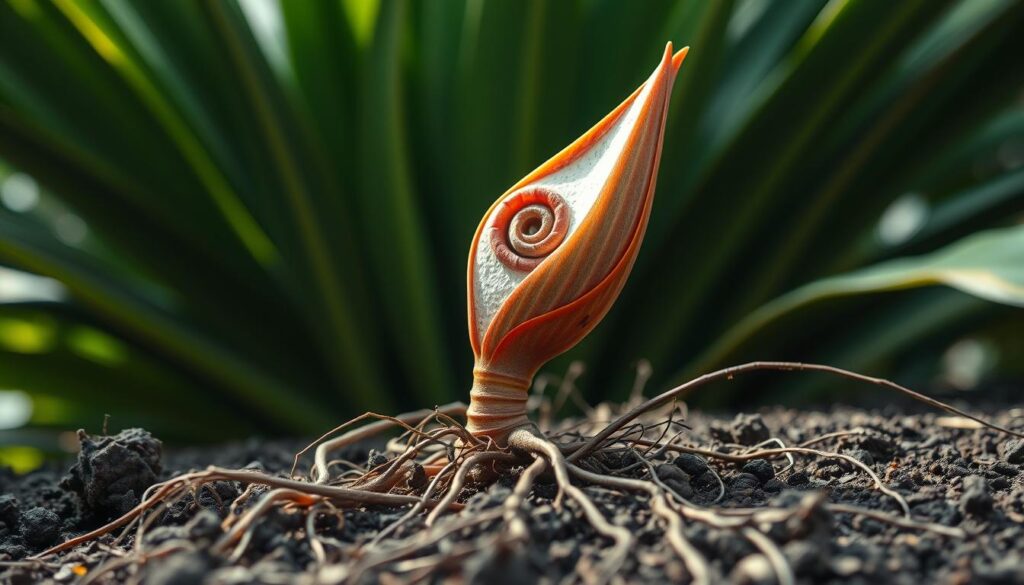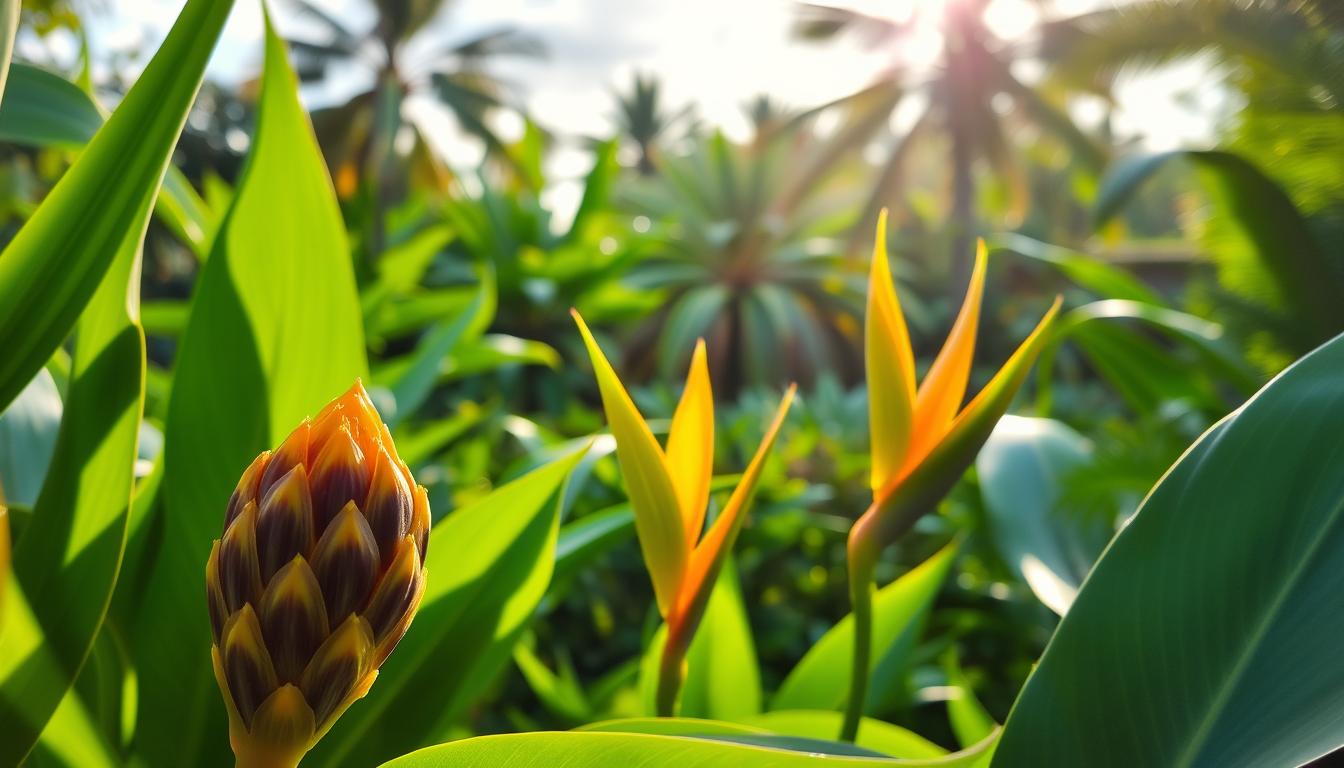Every garden has a story, and the Bird of Paradise seed tells one of tropical beauty. I remember holding these magical seeds for the first time. I dreamed of turning my backyard into a vibrant paradise.
Growing these stunning plants is like creating living art. It connects you to the wild landscapes of South Africa.
The journey of growing bird of paradise seeds is more than planting. It’s about understanding Strelitzia reginae seeds and creating the right environment. Whether you’re experienced or new to gardening, these seeds can transform your outdoor space.
Our guide will show you six amazing techniques for growing these breathtaking plants. You’ll learn how to select the right seeds and care for them. Soon, your garden will become a tropical sanctuary that will impress your neighbors.
Table of Contents
Understanding Bird of Paradise Varieties
Exploring bird of paradise plant seeds opens up a world of tropical beauty. These stunning seeds can transform your garden. Each variety has its own look and growth pattern.
Bird of Paradise plants belong to the Strelitzia genus. They have several subspecies that add drama to your garden. Knowing these varieties helps you pick the right plant for your garden.
Strelitzia Reginae – Classic Orange Variety
The Strelitzia Reginae is a popular choice for beginners. It grows 4-6 feet tall and 5-6 feet wide. It’s known for:
- Vibrant orange and blue flowers
- Compact growth for smaller gardens
- Easiest to grow
- Takes 3-4 years to bloom
Strelitzia Nicolai – White Bird of Paradise
Strelitzia nicolai is a bold choice for gardeners. It has the potential to grow as tall as 20 feet. It’s great for making a statement in your garden.
- Large white flowers
- Can grow up to 30 feet tall
- It flourishes in USDA Plant Hardiness Zones 9B to 11.
Strelitzia Caudata – Mountain Strelitzia
The Strelitzia caudata is a rare find for gardeners. It grows about six feet tall, making it a unique choice compared to more common varieties.
When picking bird of paradise seeds, think about your climate, space, and gardening level. This helps choose the best variety for you.
Bird of Paradise Seed: Essential Growing Requirements
Growing exotic seeds like a bird of paradise needs patience and careful attention. These seeds require specific conditions to grow into beautiful tropical plants. Knowing the key growing needs will help you succeed in growing these unique plants.
When starting with a bird of paradise seed, consider these critical factors:
- Germination temperature between 75°F and 85°F
- Planting depth of approximately 1 inch
- Spacing 1-3 seeds per nursery pot
- Expected germination time of 2-3 months
Preparing your seeds is crucial for their growth. Experts suggest soaking seeds before planting and using special techniques like scarification to boost germination. Patience is key – while some gardeners see growth in 21 days, others might wait months for their first sprouts.
Choosing the right growing medium is key for these exotic seeds. A mix of coconut coir, peat, and perlite in a well-draining potting mix is best. Avoid terra cotta pots during germination. Instead, use planters 2-4 inches in diameter with good drainage.
Remember, bird of paradise plants are a long-term investment. Seeds might take 3-4 years to bloom, but with proper care, you can have stunning 5-6 foot tall plants. They will turn your garden into a tropical paradise.
Optimal Soil Preparation Techniques
Growing stunning paradise flower seeds needs careful soil preparation. To grow strelitzia reginae seeds well, you must create the right growing space. This space supports the plant’s healthy growth.
Your unique plant seeds need special soil to grow. The key to growing Bird of Paradise starts with knowing and using the best soil preparation methods.
Creating the Perfect Soil Mix
To prepare the soil for your strelitzia reginae seeds, focus on these key points:
- Use a well-draining potting mix
- Add organic matter like compost
- Make the soil light and airy
- Ensure it’s rich in nutrients
pH Balance Requirements
Bird of Paradise plants like slightly acidic soil. The ideal pH range is between 5.5 and 7.5. You can check your soil’s pH with home testing kits. This helps ensure the best-growing conditions for your paradise flower seeds.
Drainage Considerations
Good drainage is key to avoiding root rot and supporting seed germination. Here are some drainage tips:
- Use pots with drainage holes
- Add perlite or sand to improve soil structure
- Create a raised bed or mound for better water flow
- Keep an eye on soil moisture
“The secret to successful Bird of Paradise cultivation lies in creating the perfect soil environment.” – Botanical Experts
Strategic Planting Time and Location
Choosing the right time and spot for your bird of paradise seeds is key. These tropical seeds need careful planning and the right conditions to grow well.
Knowing your local weather is the first step in growing these exotic seeds. Each area has its challenges and chances for growing the bird of paradise.
- In warm states like Florida and Texas, plant from late March to early June
- For cooler regions like New York and Colorado, wait until late May or June
- Ensure nighttime temperatures consistently stay above 60°F before planting
Starting seeds indoors is a great option for gardeners in cooler climates. Begin your tropical seeds indoors 8-12 weeks before the last expected frost. This gives your seeds a strong start.
“Success with exotic seeds begins with understanding their specific environmental needs” – Tropical Gardening Expert
Soil temperature is very important for seed germination. The best range is between 70°F and 85°F. Use a soil thermometer to check if the soil is right before planting your seeds.
Look for a spot that’s protected from strong winds and gets plenty of sunlight. South-facing spots usually work best for these tropical plants.
Water and Humidity Management
Growing crane flower seeds needs careful attention to water and humidity. Bird of Paradise seed management is key for healthy plants. Understanding the right moisture balance is crucial for success.
Watering Schedule Guidelines
Your bird of paradise plants need consistent moisture. In spring and summer, water them every day. In cooler seasons, water once a week. Important tips include:
- Check soil moisture before watering
- Use room-temperature water
- Ensure excellent drainage
- Avoid waterlogging roots
Humidity Control Methods
Bird of paradise plants need high humidity. In dry places, you’ll need to keep moisture up:
- Mist leaves regularly
- Use humidity trays
- Group plants together
- Place near indoor water features
Common Moisture-Related Issues
Knowing about moisture problems helps avoid plant damage. Look out for these signs:
- Curling leaves: Indicate underwatering
- Yellowing leaves: Signal low humidity
- Brown leaf tips: Suggest inconsistent watering
Mastering water and humidity management helps your bird of paradise plants thrive. They will bloom beautifully in the right environment.
Temperature and Light Requirements

Growing strelitzia reginae seeds needs careful attention to temperature and light. Your paradise flower seeds will do well if you know their needs. The best temperature for them is between 65-70°F (18-21°C).
Light is also key for healthy Bird of Paradise plants. They need:
- 6-8 hours of bright, indirect sunlight daily
- Protection from intense midday direct sunlight
- Consistent light exposure to encourage robust growth
Pro tip: Indoor gardeners can use grow lights when it’s not sunny. This helps your strelitzia reginae seeds get the light they need for healthy growth.
“The secret to successful Bird of Paradise cultivation lies in mimicking its natural tropical habitat.” – Botanical Gardens Expert
Keeping the right temperature is important for your paradise flower seeds. Don’t let them get too cold, as this can harm them. Indoor places with steady temperatures are best for these plants.
By keeping the right temperature and light, you’ll have vibrant, healthy Bird of Paradise plants. They will make your garden feel like a tropical paradise.
Essential Fertilization Methods
Looking after your bird of paradise plant seeds needs a smart fertilization plan. These tropical seeds need the right food to grow into beautiful plants. They have the potential to reach a height of up to 30 feet.
It’s key to fertilize your bird of paradise plants well for strong growth and bright flowers. Your method will change based on the plant’s age and the nutrients you pick.
Organic vs. Synthetic Fertilizer Options
You have two main choices for fertilizers for your tropical seeds:
- Organic Fertilizers: Slow-release, natural nutrients that improve soil structure
- Synthetic Fertilizers: Quick-acting, precise nutrient delivery
Seasonal Feeding Schedule
Your bird of paradise needs different nutrients at different times:
- Spring-Summer: Monthly fertilization with a balanced 5-5-5 or 10-10-10 formula
- Fall-Winter: Reduce or stop fertilization during dormancy
Nutrient Deficiency Signs
Look out for these signs that your exotic seeds might need more nutrients:
- Yellowing leaves
- Stunted growth
- Lack of flowering
- Pale or discolored foliage
By knowing these fertilization methods, you’ll give your bird of paradise plant seeds the best nutrition. This will help them grow into healthy, vibrant tropical plants that can brighten your garden for years.
Common Growth Challenges and Solutions

Growing bird of paradise seeds can be tricky for gardeners. Strelitzia reginae seeds need careful care to avoid growth problems. Knowing these common issues helps keep your ornamental seeds healthy and thriving.
Keeping pests away from bird of paradise plants is key. Even though pests are rare, watching for them is important. Using neem oil monthly helps protect your seeds from insects.
- Leaf Discoloration: Yellow or brown leaves often indicate potential issues
- Moisture Stress: Inconsistent watering can cause leaf curling
- Temperature Sensitivity: Plants struggle outside 65-75°F range
- Nutrient Deficiencies: Irregular fertilization impacts plant health
Environmental stress affects plant growth a lot. Your bird of paradise seeds might face challenges like:
- Insufficient sunlight exposure
- Improper soil drainage
- Inadequate humidity levels
- Inappropriate temperature conditions
Preventive care is crucial for success. Regular inspection, balanced nutrition, and consistent environmental conditions ensure your seeds grow well. They will become beautiful birds of paradise plants.
Pro Tip: Patience is essential when growing bird of paradise – it takes 5-6 years for plants to mature and produce beautiful flowers.
Pruning and Maintenance Techniques
Keeping your paradise flower seeds and crane flower seeds in top shape needs careful pruning and plant care. The Bird of Paradise plant needs special maintenance to grow well and look great.
Start with knowing the special needs of these unique plant seeds. Your Bird of Paradise will do well with the right pruning and regular care.
Essential Pruning Tools
To keep your Bird of Paradise in good shape, you’ll need certain tools:
- Sharp pruning shears
- Clean, sterilized cutting tools
- Gardening gloves
- Rubbing alcohol for tool sterilization
Seasonal Maintenance Calendar
Here’s a schedule to keep your plant healthy:
- Spring: Do the main pruning and shaping
- Summer: Just a little trimming and upkeep
- Fall: Take out dead leaves and get ready for winter
- Winter: Do minimal pruning, and focus on keeping it safe
Deadheading and Cleaning Techniques
Deadheading means taking off old flowers and damaged leaves. Cut the flower stalks at the base to help new growth. Also, remove yellow or brown leaves near the stem to keep the plant healthy and looking good.
Regular cleaning stops pests and helps the plant grow strong. Use a damp cloth to wipe leaves and check for disease or stress signs.
Troubleshooting and Advanced Care Tips
Growing bird of paradise plant seeds needs careful attention. Even experienced gardeners face challenges. Knowing common issues helps keep your tropical plant healthy.
Spotting problems early is key to growing a bird of paradise. Here are important troubleshooting tips for your tropical seeds:
- Watch for changes in leaf color and texture
- Regularly check the roots
- Adjust the environment as needed
- Look out for signs of nutrient deficiencies
Environmental factors greatly affect plant health. Narrow-leaved Bird of Paradise needs specific care to thrive:
| Care Aspect | Optimal Conditions | Potential Issues |
|---|---|---|
| Watering | 0.5 cups every 9 days | Root rot from overwatering |
| Sunlight | Less than 3 feet from south-facing window | Stunted growth |
| Fertilization | Every 1-2 months | Nutrient deficiencies |
Watch for warning signs when growing tropical seeds. Yellow leaves can mean too much water or lack of nutrients. Since it’s from South Africa, it likes dry conditions. Avoid too much humidity to prevent fungal growth.
For advanced care, repot when the plant grows or every year. In winter, water less and watch how it reacts to changes.
Conclusion
Growing Bird of Paradise from ornamental seeds takes patience and dedication. However, the breathtaking results make all the effort worthwhile. Your journey with Strelitzia Reginae seeds can turn your garden into a vibrant tropical paradise.
Plants can grow up to 6 feet tall, creating a dramatic visual impact. The key to success is understanding the specific care requirements for your Bird of Paradise seed. This includes maintaining optimal temperature ranges between 65-75°F and providing the right balance of indirect sunlight.
Each detail is crucial for healthy plant development. Remember, these magnificent plants can live for decades when nurtured correctly. They become true living masterpieces in your landscape.
The process might seem challenging, but your commitment will be rewarded. You’ll see breathtaking blooms and lush foliage. The 3-5-year flowering timeline might test your patience, but each stage of growth offers its beauty.
By applying the techniques and insights shared throughout this guide, you’ll be well-equipped. You’ll cultivate a thriving Bird of Paradise that will become a remarkable focal point in your garden or indoor space.
Embrace the adventure of growing these extraordinary plants. Let your passion for gardening flourish with every Bird of Paradise seed you nurture.
FAQ
How much time do Bird of Paradise seeds need to germinate?
Bird of Paradise seeds take several months to germinate. It’s important to be patient. Germination can take 1 to 3 months, depending on the variety and growing conditions.
Keep the temperature warm and the soil moist. This is key for successful germination.
What are the different varieties of Bird of Paradise plants?
Multiple varieties of Bird of Paradise plants exist. The Strelitzia Reginae is known for its vibrant orange flowers. The Strelitzia nicolai has larger white flowers.
The Strelitzia caudata is a lesser-known variety. Each variety possesses distinct characteristics and growth patterns.
What kind of soil is best for Bird of Paradise seeds?
The best soil for Bird of Paradise seeds is well-draining and nutrient-rich. Mix potting soil, perlite, and organic matter for the perfect medium.
Make sure the soil pH is slightly acidic to neutral (6.0-7.0). This prevents root rot.
How often should I water Bird of Paradise seeds and young plants?
Water Bird of Paradise seeds and young plants consistently but carefully. Keep the soil moist but not waterlogged.
Water when the top inch of soil becomes dry to the touch. Reduce watering in winter and increase humidity by misting or using a humidity tray.
What lighting conditions do Bird of Paradise plants need?
Bird of Paradise plants need bright, indirect sunlight. They need a minimum of 6 hours of light each day.
Protect them from the intense, direct afternoon sun. If indoors, place near a bright window or use grow lights.
How long does a Bird of Paradise plant take to bloom?
Bird of Paradise plants grown from seed can take 3-5 years to flower. Be patient. Optimal growing conditions can encourage earlier flowering.
What are common pests that affect Bird of Paradise plants?
Spider mites, mealybugs, and scale insects are common pests. Regularly check your plants and treat infestations early.
Use insecticidal soap or neem oil. Keeping your plants healthy and in good growing conditions can prevent pests.
Can I grow Bird of Paradise plants indoors?
Yes, you can grow Bird of Paradise plants indoors. Choose a bright location with consistent temperatures between 65-80°F.
Use a large pot with good drainage. Provide adequate humidity and rotate the plant occasionally for even growth. Some varieties, like Strelitzia nicolai, are well-suited for indoor cultivation.
What can I do to encourage blooming in my Bird of Paradise plant?
To encourage blooming, ensure your plant gets enough bright, indirect light. Maintain consistent temperatures and balanced fertilization during the growing season.
Avoid over-fertilizing with nitrogen. This may encourage leaf growth while limiting flower production. Patience and proper care are key to abundant blooming.
What is the ideal fertilizer for Bird of Paradise plants?
Use a balanced, slow-release fertilizer with an NPK ratio of 3-1-2 or 5-1-3 during the growing season. Apply every 6-8 weeks from spring through fall.
Organic options like compost or well-aged manure also provide excellent nutrition for these tropical plants.

